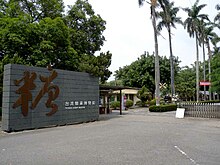Food museum
This article includes a list of references, related reading, or external links, but its sources remain unclear because it lacks inline citations. (July 2008) |

A food museum tells the story of what sustains humankind. These museums are located all around the world, and spotlight various varieties and origins of certain foods. Such museums may be specifically focused on one plant, as is the Saffron Museum in Boynes, France. They may also explore foods made from plants. For example, The Bread Museum in Ulm, Germany; a product such as the National Mustard Museum in Wisconsin; the art of food displayed at California's Copia; or historic farms, for example, Iowa's Living History Farms.
In some cases, food museums focus on how and what the world eats. Agropolis in Montpellier, France does this, as does Nestle Foundation's Alimentarium, in Vevey, Switzerland. Japan's Ramen Museum is a food museum in the form of a shopping arcade featuring different noodle restaurants and displays on ramen history.
Food tourism
[edit]The rise of food museums reflects trends in experiential tourism, including education, cultural interaction, and sensory appeal.[1] For example, the Hangzhou Cuisine Museum offers experiences that combine local food traditions with on-site dining, attracting foodie tourists seeking education, knowledge, sensory engagement, and social interaction.[2]
From 2017 to 2019, TripAdvisor, Inc. recognized the Wonder Food Museum in Malaysia and awarded it the Top Museum Award for Unique Concept and the Best Tourism Museum Award by the INPenang International Awards for exhibiting culinary heritage, diverse local cuisines and interactive displays and promoting cultural, culinary tourism.[3]
In Chicago, "Foodseum" highlights local identity with exhibitions like a hot dog-themed installation combining historical artifacts and interactive displays.[4] Foodseum also collaborates with local businesses to offer diverse educational and entertainment experiences and events, promoting local tourism.[5]
See also
[edit]References
[edit]- ^ Park, Eerang; Kim, Sangkyun; Xu, Min (2022-03-04). "Hunger for learning or tasting? An exploratory study of food tourist motivations visiting food museum restaurants". Tourism Recreation Research. 47 (2): 130–144. doi:10.1080/02508281.2020.1841374. ISSN 0250-8281.
- ^ Park, Eerang; Kim, Sangkyun; Xu, Min (2022-03-04). "Hunger for learning or tasting? An exploratory study of food tourist motivations visiting food museum restaurants". Tourism Recreation Research. 47 (2): 130–144. doi:10.1080/02508281.2020.1841374. ISSN 0250-8281.
- ^ Ser, ShawHong (2020-11-30). "THE WONDER FOOD MUSEUM STORY: CELEBRATING MALAYSIA'S FOOD CULTURE AND CULINARY HERITAGE". E-Journal of Cultural Studies: 51–69. doi:10.24843/cs.2020.v13.i04.p04. ISSN 2338-2449.
- ^ "Shibboleth Authentication Request". login.offcampus.lib.washington.edu. Retrieved 2024-10-19.
- ^ "Shibboleth Authentication Request". login.offcampus.lib.washington.edu. Retrieved 2024-10-19.
